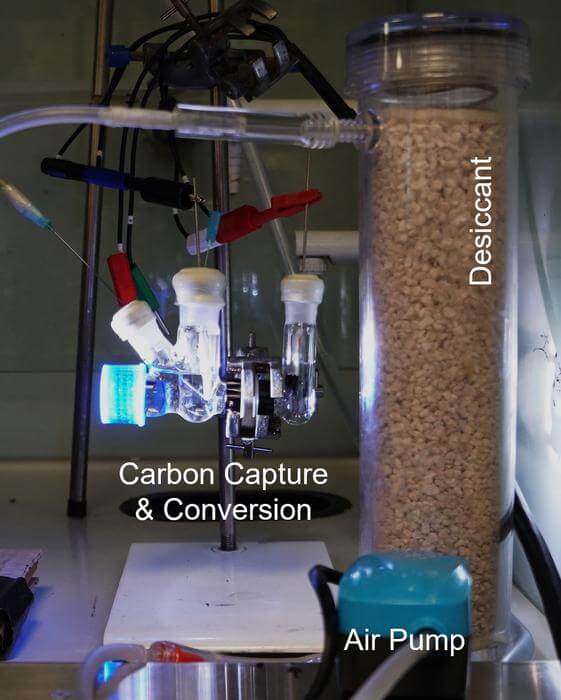CAMBRIDGE, United Kingdom — A green fuel has been synthesized from plastic bottles and thin air. This solar-powered system paves the way for affordable, eco-friendly alternatives to gasoline, diesel, and kerosene used in aviation.
During tests, CO2 was successfully converted into syngas, a crucial ingredient for sustainable liquid fuels. Simultaneously, plastic waste was processed into glycolic acid, a compound with extensive applications in the cosmetics industry. The results mark another significant stride towards producing clean fuels to energize the economy, bypassing the need for environmentally harmful oil and gas extraction.
“We’re not just interested in decarbonization, but de-fossilization – we need to completely eliminate fossil fuels in order to create a truly circular economy,” says Professor Erwin Reisner in a university release.
“In the medium term, this technology could help reduce carbon emissions by capturing them from industry and turning them into something useful, but ultimately, we need to cut fossil fuels out of the equation entirely and capture CO2 from the air.”
The team at the University of Cambridge developed a reactor that transforms greenhouse gas into clean, sustainable fuels, solely harnessing solar energy. They managed to capture and concentrate CO2 from real-world sources such as industrial exhaust and ambient air.
Prof. Reisner’s research group has been working on this technology for years, focusing on developing sustainable, net-zero carbon fuels. They have employed artificial leaves to mimic photosynthesis, the process by which plants convert sunlight into food. These devices convert CO2 and water into fuels using only solar power.
Until now, their solar-powered experiments have relied on pure, concentrated CO2 from a cylinder. However, to be practically applicable, the technology needs to actively capture CO2 from industrial processes or directly from the air. Yet, the extraction of CO2 from the various molecules present in the air we breathe poses a significant challenge.
The researchers drew inspiration from carbon capture and storage (CCS), a process where CO2 is captured, then pumped and stored underground.
“CCS is a technology that’s popular with the fossil fuel industry as a way to reduce carbon emissions while continuing oil and gas exploration,” Reisner continues. “But if instead of carbon capture and storage, we had carbon capture and utilization, we could make something useful from CO2 instead of burying it underground, with unknown long-term consequences, and eliminate the use of fossil fuels.”
The researchers adapted the system to work with flue gas or directly from the air — converting CO2 and plastics into fuel and chemicals. By bubbling air through this system containing an alkaline solution, the CO2 selectively gets trapped. Other gases present in air, such as nitrogen and oxygen, harmlessly bubble out — enabling the researchers to concentrate the CO2 in solution.
The system has two compartments: on one side, the captured CO2 solution gets converted into syngas, a simple fuel. On the other side, plastics are converted into useful chemicals using only sunlight.

“The plastic component is an important trick to this system,” co-first author Dr. Motiar Rahaman explains. “Capturing and using CO2 from the air makes the chemistry more difficult. But, if we add plastic waste to the system, the plastic donates electrons to the CO2. The plastic breaks down to glycolic acid, which is widely used in the cosmetics industry, and the CO2 is converted into syngas, which is a simple fuel.”
The scientists are currently working on a bench-top demonstrator device with improved efficiency and practicality as a path to a zero-carbon future.
“This solar-powered system takes two harmful waste products – plastic and carbon emissions – and converts them into something truly useful,” says co-first author Dr. Sayan Kar.
“Instead of storing CO2 underground, like in CCS, we can capture it from the air and make clean fuel from it,” Rahaman adds. “This way, we can cut out the fossil fuel industry from the process of fuel production, which can hopefully help us avoid climate destruction.”
“The fact that we can effectively take CO2 from air and make something useful from it is special,” Kar concludes. “It’s satisfying to see that we can actually do it using only sunlight.”
The team notes that improvements are still necessary before scientists can scale this technology up to an industrial scale.
The study is published in the journal Joule.
South West News Servicer writer Mark Waghorn contributed to this report.


This all very well and could possibly be of great help, but one question, what happens to the air that is left or will this idea if it catches on w/wide on a massive scale, denude the world of breathable air ?
lets hope that this happens for sure!